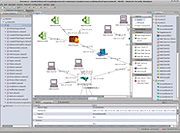Why do we need a Network Security Simulator?
In contemporary communication infrastructures, IP-based computer networks play a prominent role. The deployment of these networks is progressing at an exponential rate as different kinds of participants such as corporations, public authorities and individuals rely on sophisticated and complex services and communication systems. With regard to information security, this leads to new challenges as large amounts of data, which may hold malicious content such as worms, viruses, or Trojans, are transferred over open networks. Network security measures dealing with these threats can be implemented in the network itself as well as at hosts connected to access routers of the network. The host-based approach has its merits, especially with respect to the scalability of a resulting security framework; for example, placing security capabilities such as firewalls or virus scanners on individual hosts does not inhibit the traffic travelling through the network. However, as the hosts are generally not under the control of network operators, there is no way of ensuring a certain network-wide security policy.
A consequence for network service providers (NSPs) striving to offer improved security features to their customers as a value-adding feature is to devise a security framework in which detection devices are placed within the network. Before doing so, the NSP must take into account that it is not desirable to make frequent changes or experiment with various security feature deployments in the network infrastructure of a production system. For this reason, network operators can greatly profit from a network simulation tool in which various features of the security architectures can be tested in order to ensure maximum attack detection efficiency before the actual physical deployment. The advantage over conventional testbeds is the low cost and ease at which tests can be carried out. NeSSi² allows NSPs to experiment with different network-centric security framework setups and algorithms in order to evaluate and compare intrusion detection efficiency and operational costs. In this fashion, a devised security framework can be tested in a realistic simulation environment before the actual detection units are physically deployed in the network.
This short overview of NeSSi² is based on published papers, see our publications section for more detailed NeSSi descriptions.


